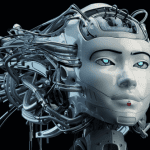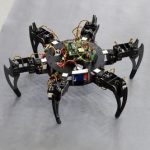 Technology
Technology  Technology
Technology  Humans
Humans 10 Everyday Human Behaviors That Are Actually Survival Instincts
 Animals
Animals 10 Animals That Humiliated and Harmed Historical Leaders
 History
History 10 Most Influential Protests in Modern History
 Creepy
Creepy 10 More Representations of Death from Myth, Legend, and Folktale
 Technology
Technology 10 Scientific Breakthroughs of 2025 That’ll Change Everything
 Our World
Our World 10 Ways Icelandic Culture Makes Other Countries Look Boring
 Misconceptions
Misconceptions 10 Common Misconceptions About the Victorian Era
 Mysteries
Mysteries 10 Strange Unexplained Mysteries of 2025
 Miscellaneous
Miscellaneous 10 of History’s Most Bell-Ringing Finishing Moves
 Technology
Technology Top 10 Everyday Tech Buzzwords That Hide a Darker Past
 Humans
Humans 10 Everyday Human Behaviors That Are Actually Survival Instincts
 Animals
Animals 10 Animals That Humiliated and Harmed Historical Leaders
Who's Behind Listverse?

Jamie Frater
Head Editor
Jamie founded Listverse due to an insatiable desire to share fascinating, obscure, and bizarre facts. He has been a guest speaker on numerous national radio and television stations and is a five time published author.
More About Us History
History 10 Most Influential Protests in Modern History
 Creepy
Creepy 10 More Representations of Death from Myth, Legend, and Folktale
 Technology
Technology 10 Scientific Breakthroughs of 2025 That’ll Change Everything
 Our World
Our World 10 Ways Icelandic Culture Makes Other Countries Look Boring
 Misconceptions
Misconceptions 10 Common Misconceptions About the Victorian Era
 Mysteries
Mysteries 10 Strange Unexplained Mysteries of 2025
 Miscellaneous
Miscellaneous 10 of History’s Most Bell-Ringing Finishing Moves
10 Surprising Stories Made Possible by Cutting-Edge Technology
Technology is constantly evolving, and its true impact often comes in ways we least expect. While some advancements grab headlines, it’s the practical, behind-the-scenes innovations that are quietly transforming the world. From AI preventing theft in small businesses to nanorobots treating brain aneurysms, cutting-edge technology is solving real-world problems with surprising ingenuity.
In this list, we’ll dive into ten remarkable stories where technology stepped in at just the right moment. What ties these stories together is their ability to challenge the status quo. They demonstrate how thoughtful engineering and innovation can offer fresh perspectives on longstanding issues, turning what once seemed impossible into routine evolutions.
Related: 10 Technologies That Are Bringing Us Closer to Being Cyborgs
10 Modern Technology Helps a Viking Ship Return Home
Transporting a Viking ship across the Atlantic is no small feat, but modern technology made it possible. The Draken Harald Hårfagre, the largest Viking ship of its kind in the modern era, needed to return to Norway after several years of educational tours in the United States. Sevenstar Yacht Transport took on the responsibility, using advanced equipment and expert planning to ensure the ship’s safe passage.
The process involved more than just heavy lifting. The team used custom-designed cradles, hydraulic systems, and precise calculations to load the 115-foot (35-meter) ship onto a transport vessel in Newport, Rhode Island. Every detail, from weight distribution to the ship’s structural integrity, was carefully considered, making sure the Draken arrived in Norway without any damage.
This operation demonstrates how modern technology can be used to preserve historical treasures. Thanks to the expertise and precision of the team, the Draken will continue its mission of education and exploration for many years to come.[1]
9 AI Takes on Shoplifters in Small Stores
For small businesses, shoplifting is a constant drain on profits, but now, artificial intelligence is stepping in to make a difference. Veesion, a tech company from France, developed AI software that analyzes security camera footage to spot suspicious movements. Unlike traditional systems, this AI isn’t focused on appearances—it zeroes in on actions like hiding items in pockets, bags, or baby strollers.
At Wild Duck Wine & Spirits in Boston, this AI-powered system has become a game changer. It alerts staff within seconds of detecting these sneaky gestures, giving them enough time to intervene before someone leaves the store. It’s fast, effective, and allows employees to focus on customers instead of monitoring screens.
What makes this technology stand out is its accessibility. It’s affordable and easy to install, making it a practical solution for small businesses that can’t afford extra security staff. With AI like Veesion, stores are gaining a powerful tool to reduce theft and protect their profits.[2]
8 AI Security Center Keeps DOD ahead of the Game
Artificial intelligence is transforming national security, and the U.S. Department of Defense (DOD) isn’t taking any chances. To stay ahead, the DOD launched its AI Security Center, led by the National Security Agency (NSA). This new hub focuses on safeguarding AI technology while making sure it’s used responsibly. From protecting AI models to guarding intellectual property, the center is setting the standard for secure AI in defense.
Air Force General Timothy D. Haugh, head of U.S. Cyber Command, emphasized the center’s importance in defending against AI threats. The center’s work isn’t just about adopting AI for military use—it’s also about understanding how adversaries might misuse it. By developing security practices and monitoring risks, the NSA is helping ensure the DOD stays prepared.
This initiative highlights the DOD’s commitment to leading in AI and keeping U.S. forces a step ahead. With the AI Security Center, the future of warfare is evolving, and the DOD is ready to meet the challenges that come with it.[3]
7 The World’s Largest Wind Turbine Changes the Game for Clean Energy
In a groundbreaking move for renewable energy, Mingyang Smart Energy has installed the world’s largest offshore wind turbine off the coast of Hainan, China. This 20-megawatt giant, with a rotor spanning nearly 1,000 feet (305 meters), can generate enough electricity to power 96,000 homes annually. Its massive blades sweep an area larger than 12 football fields, capturing the full force of offshore winds.
What really sets this turbine apart is its ability to handle extreme weather. Built to endure typhoon-level winds reaching up to 178 miles per hour (286.5 kilometers per hour), it’s designed for both power and durability. Offshore turbines like this are a crucial part of the shift to renewable energy, as they generate more consistent and reliable power compared to their land-based counterparts.
Mingyang’s latest turbine showcases how far wind energy has come. With innovations like these, clean energy is becoming more efficient, scalable, and ready to meet global demands for a greener future.[4]
6 Iron-Air Battery Changes Renewable Energy Storage in Maine
Maine is taking a big step in renewable energy with the world’s largest iron-air battery, developed by Form Energy. This 85-megawatt system will store energy from wind and solar, making it available when these sources aren’t generating power. Located on the site of an old paper mill, the battery can discharge energy for up to 100 hours, giving the region’s grid much-needed reliability during times of high demand.
What sets this battery apart is its use of iron-air technology, a safer and more affordable alternative to lithium-ion batteries. By converting iron oxide into iron to store energy and reversing the process to release it, this system offers a cost-effective solution for long-term energy storage. With the capacity to power up to 85,000 homes, this project represents a major leap in balancing supply and demand, helping the region move closer to a clean and dependable energy future.[5]
5 Illinois Pioneers Newborn Screening for Rare Genetic Disorder
Illinois has taken a groundbreaking step by becoming the first state to screen newborns for metachromatic leukodystrophy (MLD), a rare but devastating genetic disorder. This new initiative, driven by a local family’s advocacy, ensures that infants born in the state will now have access to early diagnosis. The law, signed by Governor JB Pritzker, offers hope for treatments like gene and stem cell therapies, which could slow or stop the disease’s progression if caught in time.
MLD affects the nervous system, and without early intervention, the condition can be fatal within just five years. However, early detection through newborn screening could be life-changing, providing an opportunity for life-saving therapies that were once out of reach. This new addition to Illinois’ screening program marks a significant advancement in preventing the worst outcomes for children with this condition.
By leading the way in newborn screening, Illinois is setting a powerful example for other states to follow, potentially saving countless lives in the process.[6]
4 Panic Alarm System Prevents Tragedy in Georgia School Shooting
A new panic alarm system at Apalachee High School in Georgia likely saved numerous lives during a recent school shooting. Installed just a week before, the system was triggered as soon as the violence began. With a press of a button, teachers alerted law enforcement, who arrived within minutes, stopping the shooter before more harm could be done. The fast response turned what could have been a far worse tragedy into a moment of swift, life-saving action.
Developed by Centegix, the system allows teachers to activate an alert by pressing a button on their ID badges. The system immediately sends GPS coordinates to law enforcement, giving them the exact location of the emergency. It also activates lockdown warnings in classrooms, guiding students and staff to take cover and follow safety procedures.
This technology is a game-changer for school safety. Advocates now hope to see it adopted nationwide, believing that it can make all the difference in future school emergencies.[7]
3 Drone Technology Rescues Missing Boy from 100-Acre Cornfield
When a three-year-old boy went missing in a 100-acre(405-hectare) cornfield in Wisconsin, time was of the essence. After hours of searching the property with no sign of him, authorities brought in a drone equipped with thermal imaging. Within minutes, the drone detected a heat signature deep within the cornfield, giving officers the exact location they needed.
The child had wandered into the field while chasing a cat and had been lost for nearly two hours. Thanks to the drone, officers were able to find him quickly and safely return him to his family. Without the drone’s thermal capabilities, the search might have taken hours longer, with potentially dangerous consequences.
This rescue highlights how technology can make all the difference in life-or-death situations. What could have been a tragic outcome was avoided because of tools that allow us to act faster and more precisely when it matters most.[8]
2 First Metal Part 3D-Printed in Space Paves the Way for Future Missions
In a major leap for space exploration, astronauts aboard the International Space Station (ISS) have 3D-printed the first metal part entirely in space. Using a specially designed metal printer built by Airbus, this achievement marks a significant step toward deeper space missions. The ability to create tools and spare parts on demand could reduce reliance on Earth resupplies, making long-duration missions to the Moon, Mars, and beyond more feasible.
The metal printer, about the size of a washing machine, was installed in the ISS earlier this year. Unlike plastic-based 3D printing previously done in space, this system uses wire-based printing, which is more suited for microgravity. The first printed part will be sent back to Earth for testing, but it represents a huge potential shift in how astronauts maintain and build equipment in space.
With technology like this, the dream of building entire structures on other planets is becoming more realistic. From tools to infrastructure, 3D printing could be the key to long-term space exploration.[9]
1 Nanorobots Could Transform the Way Brain Aneurysms Are Treated
In a groundbreaking development, scientists have created nanorobots that could revolutionize the treatment of brain aneurysms. These tiny robots, smaller than a blood cell, are designed to deliver clot-forming drugs right to the source of an aneurysm. Guided by a magnetic field, the nanorobots travel through the bloodstream to precisely target the weakened blood vessel, releasing medication to seal it off and prevent a potential rupture.
What makes this technology especially exciting is how it offers a safer, less invasive alternative to traditional treatments like stents. There’s no need for blood thinners, and the process minimizes the risks associated with more invasive procedures. In early animal trials, the nanorobots successfully treated aneurysms in rabbits, showing significant promise for future use in humans.
If this technology passes further testing, it could mark a huge leap forward in stroke prevention and aneurysm care. These tiny robots could become a key tool in modern medicine, offering a faster and more precise way to treat life-threatening conditions.[10]








